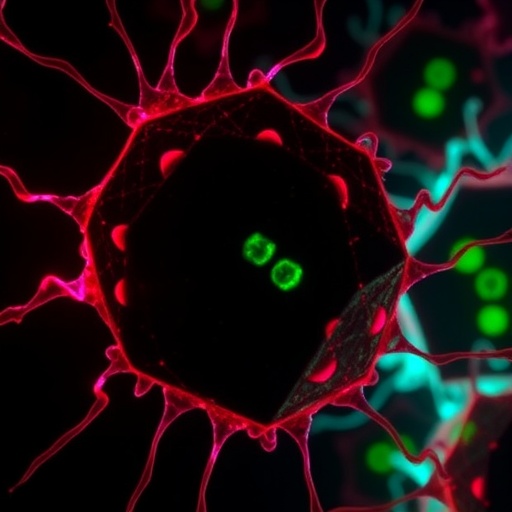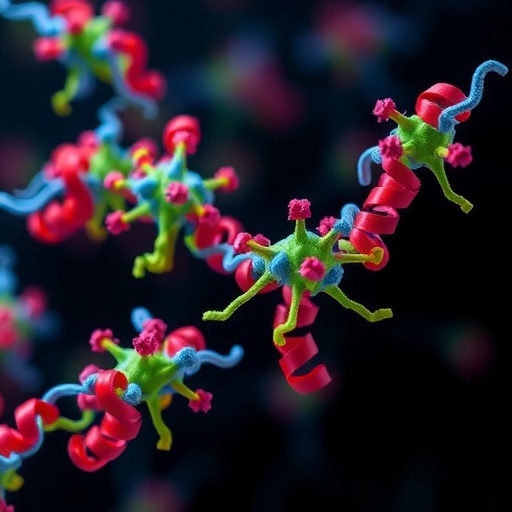In a groundbreaking study recently published in Nature Communications, researchers have unveiled a critical molecular mechanism by which the enzyme ACSS2 mitigates cellular damage in the liver caused by chronic alcohol consumption. This discovery provides an unprecedented insight into the pathogenesis of alcohol-induced liver injury, specifically focusing on a novel form of regulated cell death known as ferroptosis. By elucidating how ACSS2 influences hepcidin expression to shield hepatocytes from ferroptosis, this research opens new avenues for therapeutic intervention aimed at preventing liver failure in patients with alcohol-related liver disease.
Alcohol-induced liver disease remains a dominant cause of morbidity and mortality worldwide, yet the precise molecular pathways driving hepatocyte death have remained obscure until recently. Chronic exposure to ethanol results in oxidative stress within hepatocytes, leading to lipid peroxidation—a hallmark trigger for ferroptosis. Ferroptosis, distinct from other cell death modalities such as apoptosis or necrosis, is iron-dependent and driven by the accumulation of lethal lipid peroxides. The regulation of iron homeostasis within hepatocytes is therefore critical to modulating susceptibility to ferroptosis, but the specific biological mediators bridging alcohol metabolism, iron regulation, and ferroptotic cell death were poorly understood.
The study spearheaded by Wang, Wen, Feng, and colleagues focuses on whether and how acetyl-CoA synthetase short-chain family member 2 (ACSS2), a metabolic enzyme pivotal in acetyl-CoA production, influences hepcidin synthesis in hepatocytes under alcohol stress. Hepcidin is the master regulatory hormone governing systemic iron homeostasis by controlling ferroportin-mediated iron export. Dysregulation of hepcidin expression can lead to abnormal iron accumulation, exacerbating oxidative stress and inducing ferroptosis. The team hypothesized that ACSS2 exerts a protective effect by modulating hepcidin pathways to maintain iron balance during ethanol-induced toxicity.
.adsslot_ItvrC1HN7z{ width:728px !important; height:90px !important; }
@media (max-width:1199px) { .adsslot_ItvrC1HN7z{ width:468px !important; height:60px !important; } }
@media (max-width:767px) { .adsslot_ItvrC1HN7z{ width:320px !important; height:50px !important; } }
ADVERTISEMENT
Using a combination of in vitro hepatocyte models and in vivo murine systems subjected to chronic ethanol exposure, the investigators meticulously delineated the role of ACSS2. They discovered that ACSS2 expression is upregulated in response to alcohol metabolism, which in turn facilitates the acetylation of key transcriptional regulators responsible for activating hepcidin gene expression. This epigenetic activation ensures adequate hepcidin production, promoting iron sequestration within storage complexes and limiting free intracellular iron that catalyzes lipid peroxidation.
Critically, loss-of-function experiments revealed that deletion or inhibition of ACSS2 aggravated alcohol-induced ferroptosis, as evidenced by increased lipid peroxidation markers, iron overload, and hepatocyte death. Conversely, pharmacological enhancement of ACSS2 activity restored hepcidin levels and dramatically reduced cellular damage. These findings underscore a previously unappreciated metabolic-epigenetic axis that governs ferroptotic susceptibility through iron regulation in liver cells exposed to alcohol.
The implications of these findings are manifold. Firstly, they clarify the mechanistic bridge linking metabolic alterations induced by chronic alcohol intake to iron-mediated toxic lipid accumulation. Establishing ACSS2 as a central protector aligns metabolic enzyme function with transcriptional control of iron homeostasis, providing a new conceptual framework for understanding liver injury. Secondly, the study identifies hepcidin not just as a systemic iron regulator but as a critical intracellular safeguard in hepatocytes responding to oxidative insults.
From a therapeutic standpoint, targeting the ACSS2-hepcidin axis may represent a promising strategy for mitigating liver damage in alcohol use disorders. Currently, treatment options for alcoholic liver disease are limited and largely supportive. The ability to pharmacologically manipulate ACSS2 activity could confer hepatoprotection by preventing ferroptosis, delaying or even reversing liver failure progression. Moreover, this approach has the potential to synergize with antioxidant therapies to combat oxidative stress more effectively.
The study’s technical rigor also highlights the integration of advanced molecular biology techniques—such as chromatin immunoprecipitation sequencing and iron quantification assays—with classical hepatotoxicity models to uncover critical pathways. By quantifying levels of 4-hydroxynonenal and malondialdehyde, the team substantiated the occurrence of lipid peroxidation as a mediator of ferroptosis. Additionally, the use of ferrostatin-1, a known ferroptosis inhibitor, further validated that the observed hepatic damage was ferroptosis-dependent.
Interestingly, the research also touches upon the broader context of ACSS2’s role in other metabolic diseases and cancers, where altered acetyl-CoA metabolism and iron dysregulation are common. This suggests that the protective mechanism delineated here might have relevance beyond alcoholic liver injury, potentially impacting a wide range of pathologies where ferroptosis contributes to cell death.
The questions raised by this study are compelling. For instance, what upstream signals drive ACSS2 upregulation in response to ethanol? Could genetic variations in ACSS2 or hepcidin pathways predispose individuals to more severe alcohol-related liver injury? And importantly, how might diet and other environmental factors modulate this protective mechanism? Future research aimed at answering these queries will further clarify the role of the ACSS2-hepcidin axis in liver health.
Moreover, as ferroptosis gains increased attention across multiple disciplines, from neurodegeneration to oncology, this study provides a pivotal example of how metabolic enzymes influence cell fate decisions in a disease-relevant context. The ability to harness such pathways for therapeutic benefit underscores the critical importance of metabolic regulation in cell death paradigms.
In sum, the work by Wang, Wen, Feng, and colleagues makes a significant contribution to the field of hepatology and cell death biology by revealing how ACSS2 orchestrates a protective response against alcohol-induced ferroptosis through regulating hepcidin expression. This research not only advances fundamental understanding but also charts a promising path towards novel interventions for alcohol-induced liver diseases, which remain a substantial public health burden globally.
As this study gains traction, it is anticipated to stimulate a wave of research focused on the intersection of metabolism, iron regulation, and ferroptosis, advancing the quest to develop effective, targeted therapies. The elucidation of such intricate molecular interplay reminds us of the remarkable complexity of cellular survival mechanisms and the potential to harness these insights to combat some of the most challenging diseases of our time.
Subject of Research: Alcohol-induced hepatocyte ferroptosis and the protective role of ACSS2 via regulation of hepcidin expression.
Article Title: ACSS2 protects against alcohol-induced hepatocyte ferroptosis through regulation of hepcidin expression.
Article References:
Wang, M., Wen, X., Feng, Z. et al. ACSS2 protects against alcohol-induced hepatocyte ferroptosis through regulation of hepcidin expression. Nat Commun 16, 5491 (2025). https://doi.org/10.1038/s41467-025-61067-8
Image Credits: AI Generated
Tags: ACSS2 enzyme functionalcohol-induced liver injuryalcohol-related liver disease researchchronic alcohol consumption effectsferroptosis in hepatocyteshepatocyte protection strategieshepcidin expression regulationiron homeostasis in liver cellslipid peroxidation mechanismsmolecular pathways of liver cell deathoxidative stress in hepatocytestherapeutic interventions for liver disease




